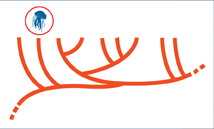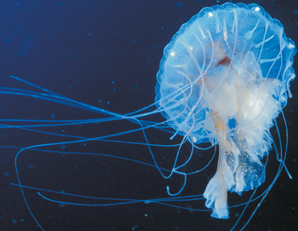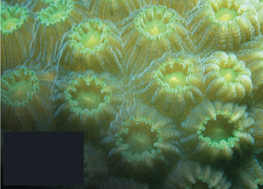Cnidarians


Sea Nettle
KEY CHARACTERISTICS
Cnidarians are aquatic, mostly carnivorous, and the simplest animals to have specialized tissues (outer skin and lining of the gastrovascular cavity) and body symmetry (radial). Their tentacles have stinging cells called nematocysts used in feeding.
Feeding and Digestion Predatory, stinging prey with nematocysts; digestion begins extracellularly in gastrovascular cavity and is completed intracellularly; indigestible materials leave body through single opening; many, especially reef-building corals, also depend on symbiotic algae, or zooxanthellae.
Circulation No internal transport system; nutrients typically diffuse through body.
Respiration Diffusion through body walls
Excretion Cellular wastes diffuse through body walls.
Response Some specialized sensory cells: nerve cells in nerve net, statocysts that help determine up and down, eyespots (ocelli) made of light-detecting cells
Movement Polyps stationary, medusas free-swimming; some, such as sea anemones, can burrow and creep very slowly; others move using muscles that work with a hydrostatic skeleton and water in gastrovascular cavity; medusas such as jellyfish move by jet propulsion generated by muscle contractions.
Reproduction Most—alternate between sexual (most species by external fertilization) and asexual (polyps produce new polyps or medusae by budding)
Eco•Alert
Coral Symbionts
Reef-building coral animals depend on symbiotic algae called zooxanthellae for certain vital nutritional needs. In many places, reef-building corals live close to the upper end of their temperature tolerance zone. If water temperatures rise too high, the coral-zooxanthellae symbiosis breaks down, and corals turn white in what is called “coral bleaching.” If corals don't recover their algae soon, they weaken and die. This is one reason why coral reefs are in grave danger from global warming.

The color of this star coral is caused by zooxanthellae algae living within it.
Table of Contents
- Formulas and Equations
- Applying Formulas and Equations
- Mean, Median, and Mode
- Estimation
- Using Measurements in Calculations
- Effects of Measurement Errors
- Accuracy
- Precision
- Comparing Accuracy and Precision
- Significant Figures
- Calculating With Significant Figures
- Scientific Notation
- Calculating With Scientific Notation
- Dimensional Analysis
- Applying Dimensional Analysis




